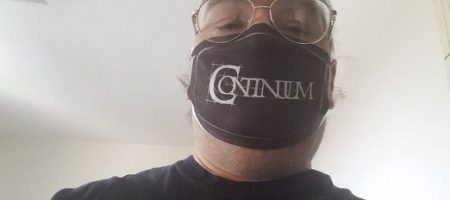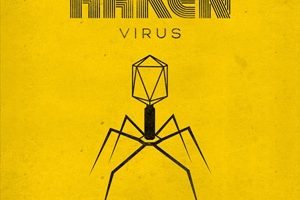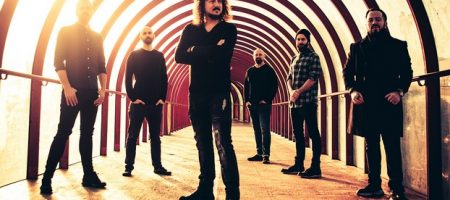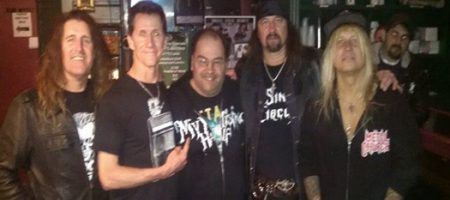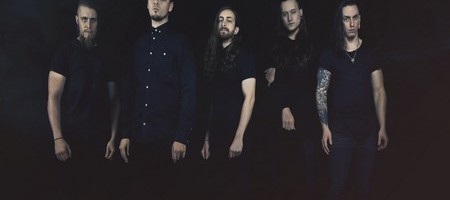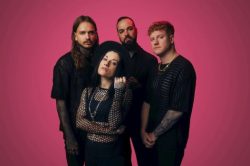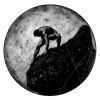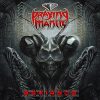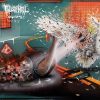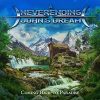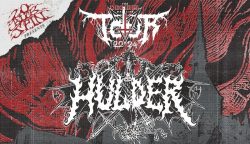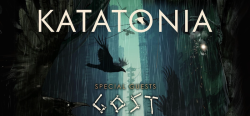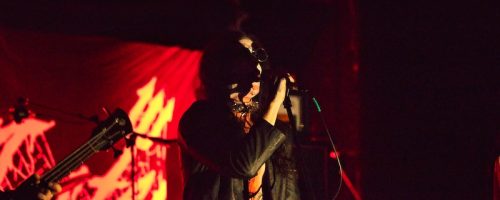Haken – To Affinity…and Beyond
Sunday, 27th March 2016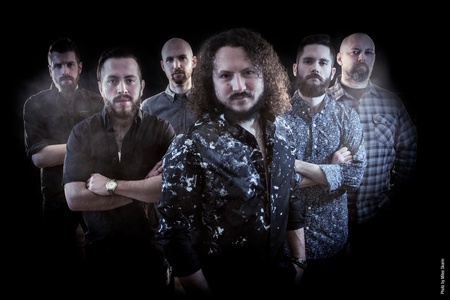
Progressive music has a fervent, enduring following – beyond musicianship and into a kinship of sorts between the musicians who create and produce songs and albums into the listeners that take it in, processing and mulling over parts, words, and arrangements for a lifetime. Another serious player in the scene since 2007, UK’s Haken (rhymes with bacon) have already released three full-lengths and an EP in relatively short order – attaining a foothold through exemplary abilities plus a wide array of influences the sextet use at their disposal.
Their fourth album Affinity fluctuates between shorter, tighter constructs that still leave jaws agape because of technical prowess and melodic continuity (see first video “Initiate”) and sprawling epic-length efforts that progressive-minded folks cherish and expect (place 15:40 centerpiece “The Architect” here). To these ears Haken appear to be on par with Norway’s Leprous in terms of high quality progressive metal output year in and year out – possibly usurping Dream Theater who fail to surprise us anymore this deep into their career.
Speaking with drummer Raymond Hearne across Skype lines, this half-hour conversation flowed quickly. You’ll learn more about the collaborative approach behind the new record – the challenges vocalist Ross Jennings faces in terms of lyrics during the ever changing songwriting process, as well as a little bit of debate regarding vocalists and drummers for one of Raymond’s all-time favorites Iron Maiden.
Dead Rhetoric: Affinity is the newest Haken studio album – and the most collaborative in terms of initial idea development by the band members together. How do you feel this process went, and what songs do you think benefit the most from this push and pull approach?
Raymond Hearne: All of that is correct. How do I think it’s worked? It definitely in this case made the album a slower process, that’s partly because we haven’t been able to work so much as a band in a band room. We’ve been doing it a lot through e-mail, Logic Projects and sending those back and forth, editing them. We were able to meet up in a little period where we were all at the same place at the same time, because we are so spread out as a band. One of the guys is based in Indiana, the other guy is based in Mexico City, so we are quite spread out so it does make it a bit difficult in that sense. Overall it’s definitely been a good thing- the more collaborative we are, the less predictable we can be. Given that there are so many ideas going on, so long as we make sure we are still able to form those ideas into something coherent. I think it’s only a good thing. We’ve got all six of us with diverse music tastes- if it was just one or two of the guys, it just wouldn’t be as broad musically. I think one of the things that we all appreciate in music is the fact that there are so many different styles that we all love and like to incorporate in some way.
Any particular songs… to be honest I can’t really think of any that stick out as such. Because it has been so collaborative in general, they all benefit. For example, I wrote “The Endless Knot” more or less, but in the earlier stages I had written a couple of sections that I wasn’t sure how to join them together or set on the structure or form to the verse. (Guitarist/keyboardist) Richard (Henshall) and myself met up and we worked on a verse idea. You could say the same for pretty much anything on the album – (guitarist) Charley’s big two tracks are “The Architect” and “1985”, they are the two longest songs but there is still a huge amount of collaboration- he would send sections to us, there would be push and pull between the members.
Dead Rhetoric: How does the band tackle the delicate balance between technical intricacy and maintaining a sense of groove/melodic cohesion so that you leave the listener with material that’s exciting and memorable? On this new record highlights for me include the almost 16 minute “The Architect” as well as the uplifting, majestic but shorter follow up “Earthrise”…
Hearne: Yeah, let me think. Maybe one of the problems you could find, or some people might hear with progressive music in general, is that it’s kind of technical for the sake of it or a big mash up of things. We can be guilty of that in the past, or might still be, but we are conscious of that problem. We are into technical music as well as more simple music, we really want to challenge ourselves but one of the main things is making sure melodically, especially vocally, having choruses that people can really latch onto. Solid melodies, things that stick in people’s heads. Myself as a drummer, I try to keep things as simple as possible in a way. If you are playing 7/8 over 13/8, loads of different time signature changes and crazy structures, it makes more sense to lay something down underneath that binds it together and makes it sound simpler than it might be or look on paper. “The Architect” has some really technical moments, “Earthrise” is a much more poppy song perhaps, and it’s one of the songs that went through a lot of versions because of the collaborative process before we really agreed on a final format.
Dead Rhetoric: The keyboard and electronic drum elements in “1985” certainly take on characteristics of that year sonically – a conscious throwback or a natural evolution?
Hearne: It was both I guess. We were quite vocal about the idea of explicitly accessing this 80’s sound that we all really dig. If you take an amazing soundtrack like Rocky IV, I believe it came out in 1985 and a lot of the music was written by Vince DiCola, he’s one of those brilliant composers with an instantly recognizable sound- although I don’t think he became as big as he should have. I get that impression anyway, because he doesn’t have a huge list of works to his name. He’s someone that we all just really love, we tried to get into his sound. We went for the hard hitting, funky sort of pop stuff from the 80’s. It’s nice for me to broaden the drum sound, as I like the idea of when playing this live playing some electronic sounding drums beyond the usual acoustic drums. I like the idea of having this hybrid set up live and being able to broaden things.
Dead Rhetoric: Ross Jennings as a vocalist must have a difficult decision to figure out where sometimes to place his verses amidst a lot of the progressive tempo changes and outstanding riffing/segment syncopation – does his work come in after most of the music sections are mapped out, or is he also a part of this ever-evolving composition formula?
Hearne: He’s definitely a part of it. The problem that Ross has is we are all constantly changing the structure or getting rid of sections and adding in new ones, by which time Ross has already formulated a whole verse or a whole chorus or an entire song. It makes things tough, he’s focused on the vocals and lyrics, that’s his things. When we come along and say that we are not really feeling this bit, let’s extend this and having to deal with constant changes is tough. But I think he’s used to it now, used to our working format that we’ve got. It can be tricky, when you might have one or two songs causing problems it can take a while to sort of really agree what approach would be best for a particular song. When we get to the stage where we are recording vocals and finalizing lyrics, we will be finishing sections of songs and recording vocals at the same time- it’s always really down to the wire. It’s been the same with all the albums, there have been sometimes that we are finished a musical section the day before and in the moment we have to figure out what to do lyrically. It forces us to come up with something, more often than not it turns out for the better although it feels quite stressful at the time. I don’t think that’s ever going to change, that’s just how we work.
Dead Rhetoric: When it comes to the lyrics, what is Ross’ outlook on the content for the band?
Hearne: It’s the same for all of us. Ross takes specific ideas or experiences or concepts and making sure the lyrics fit that idea coherently. There may be a clear narrative on a particular song or a more general idea- I think something that we’ve learned from writing The Mountain is it’s really good to make sure our lyrics can be more broadly interpreted. The previous albums Visions and Aquarius were narrative based, there was a clear story with character development. We like the idea of giving music to our fans that they can apply to their own personal experiences and their own lives, without limitations of what happens here or there. We love hearing that certain songs support people going through a certain time in their lives, having more accessible lyrics.
Dead Rhetoric: Can you tell us about the art work for Affinity – which seems rather straightforward in direct contrast to your music?
Hearne: Yeah, I guess you could say that. It’s got quite a more minimal look to it. As you might be able to see, it harkens back to a lot of the 1980’s – a lot of cassette tapes inlays and things like that. We went through quite a few versions of the artwork, we had some more modern looking styles going on. It’s nice to come up with a different sort of visual thing for each album, I think we have a nice theme with this one. It opens things up to interpretation – the inlay also follows the same minimalist theme.
Pages: 1 2











